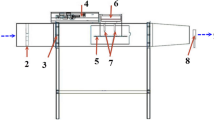Abstract
In order to research the drying efficiency of a rotary dryer, a three-dimensional simulation model of roller is built. The temperature distribution in the dryer is simulation modeled using Fluent code, and the simulation result is contrastively analyzed by a thermal imaging test. Using the material curtain distribution location and uniformity as evaluation parameters, EDEM studies the impact of the dryer’s internal structural parameters and the production parameters on the material curtain distribution characteristics. A contrast experiment is conducted to obtain the optimized structural parameters and production parameters of a rotary dryer.
Similar content being viewed by others

Abbreviations
- G1 :
-
yield of the drying drum
- C1 :
-
moisture content of dry basis of initial material
- C2 :
-
moisture content of dry basis of product
- W1 :
-
water content of initial material
- W2 :
-
water content of product
- Gc :
-
amount of dry material
- G0 :
-
feed rate of sands
- W:
-
rate of evaporation
- Q1 :
-
heat quantity of evaporating water in wet material
- Q2 :
-
heat quantity of heating up material
- Q3 :
-
thermal energy loss through system
- Q:
-
total heat required
- q:
-
latent heat of vaporization
- Cs :
-
specific heat capacity of steam
- T2 :
-
flue gas temperature
- Cw :
-
specific heat capacity of water
- tm1 :
-
feed temperature
- Gc :
-
dry material amount
- Cm :
-
specific heat capacity of dry material
- tm2 :
-
discharge temperature
- m1,2 :
-
equivalent mass of particle
- I1,2 :
-
equivalent rotational inertia of particle
- s:
-
radius of gyration
- un :
-
normal displacement of particle
- us :
-
tangential displacement of particle
- θ :
-
rotation angle of particle
- Fn :
-
normal force acting on particle
- Fs :
-
tangential force acting on particle
- M:
-
external torque
- Kn :
-
normal elasticity coefficient
- Ks :
-
tangential elasticity coefficient
- cn :
-
normal damping coefficient
- cs :
-
tangential damping coefficient
- μ :
-
friction coefficient between particles
References
Shi, Y.-C. and Chai, B.-Y., “Present Situation and Development Tendency of Chinese Drying Technology,” Drying Technology & Equipment, vol. 4, no. 3, pp. 122–130, 2006.
Jin G., “Drying Equipment,” Chemical Industry Press, p. 1, 2002. (In Chinese)
Wardjiman, C. and Rhodes, M., “Heat Transfer in a Particle Curtain Falling through a Horizontally-Flowing Gas Stream,” Powder Technology, vol. 191, no. 3, pp. 247–253, 2009.
Li, H., Kong, D., and Wang, P., “Numerical Simulation of Inner Flow Field and Heat-Transfer Process for Drying Drum,” Journal of Engineering Machinery, Construction Machinery and Equipment, vol. 42, no. 6, pp. 20–23, 2011. (In Chinese)
Tianjin, Y., Di, Y., Cheng, Y., and Yang, B., “Numerical Simulation of Temperature Field of Renewable Asphalt Mixing and Drying Drum,” Journal of Construction Machinery Technology, vol. 5, no. 3, pp. 267–271, 2007. (In Chinese)
Wardjiman, C., Lee, A., Sheehan, M., and Rhodes, M., “Behaviour of a Curtain of Particles Falling through a Horizontally-Flowing Gas Stream,” Powder Technology, vol. 188, no. 2, pp. 110–118, 2008.
Peinado, D., De Vega, M., García-Hernando, N., and Marugán-Cruz, C., “Energy and Exergy Analysis in an Asphalt Plant’s Rotary Dryer,” Applied Thermal Engineering, vol. 31, no. 6-7, pp. 1039–1049, 2011.
Hobbs, A., “Simulation of an Aggregate Dryer using Coupled CFD and Dem Methods,” International Journal of Computational Fluid Dynamics, vol. 23, no. 2, pp. 199–207, 2009.
Eymard, R., Gallouët, T., and Herbin, R., “Finite Volume Methods,” Handbook of Numerical Analysis, vol. 7, pp. 713–1018, 2000.
Hu, G., “Analysis and Simulation of Granular by Discrete Element Method Using EDEM,” Wuhan University of Technology Press, pp. 178–179, 2010. (In Chinese)
Geng, F., Xu, D., Yuan, Z., Wang, H., and Li, Bin., “Three Dimensional Numerical Simulation of Mixing Characteristics of Slender Particles in Rotary Dryer,” Journal of Southeast University (Natural Science Edition), vol. 38, no. 1, pp. 116–122, 2008. (In Chinese)
Kim, S., Kim, T., Lee, G.-B., Park, Y.-J., and Cho, S. W., “Parametric Numerical Study for Energy Savings in Industrial Drying Process,” Int. J. Precis. Eng. Manuf., vol. 15, no. 3, pp. 513–518, 2014.
Cleary, P. W., “Industrial Particle Flow Modelling using Discrete Element Method,” Engineering Computations, vol. 26, no. 6, pp. 698–743, 2009.
Author information
Authors and Affiliations
Corresponding author
Rights and permissions
About this article
Cite this article
Chen, S., Yang, J. Simulation and experiments on the drying outcome of drying drums. Int. J. Precis. Eng. Manuf. 17, 109–117 (2016). https://doi.org/10.1007/s12541-016-0014-z
Received:
Revised:
Accepted:
Published:
Issue Date:
DOI: https://doi.org/10.1007/s12541-016-0014-z


